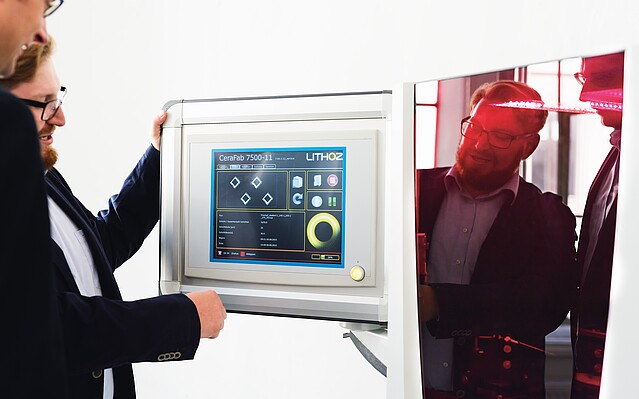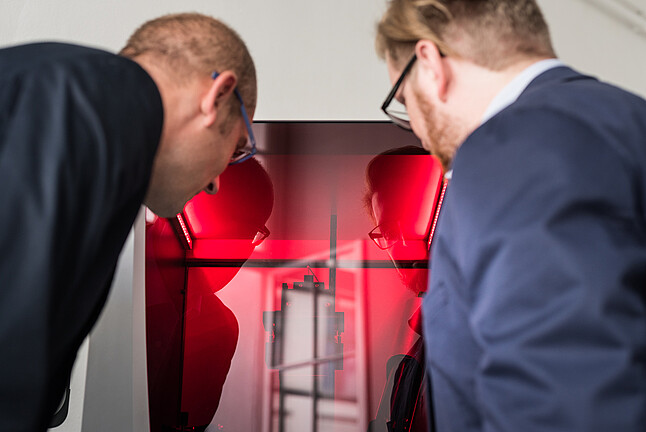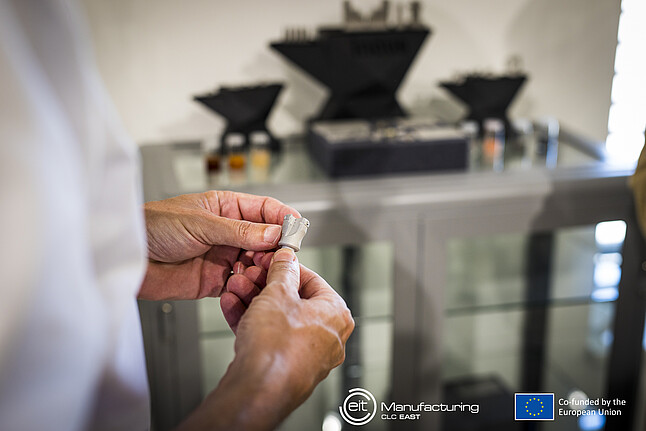3D-printed bones and spare parts from moon dust: Vienna at the forefront of additive manufacturing
April 29, 2024|LD
Leaders in the field of lithographic 3D printing, tech pioneer Lithoz and its spin-off incus make printers for ceramics and metal that efficiently create high-performance parts. Their technology opens new avenues for development in many sectors, including space science.
Can debris from space be used to produce spare parts? This was one of the questions that Viennese startup incus spent eighteen months trying to answer. As part of a collaboration with the European Space Agency, the company conducted ground-breaking research on the use of 3D printing for future lunar missions. The results showed that recycled materials, such as metal scraps from the moon, could be used to print high-quality parts using lithography-based metal manufacturing. What’s more, the research shows immense potential for the on-site production of parts through a zero-waste workflow, which could have big implications for the future of human settlement on the moon.
The application of lithography-based additive manufacturing is also making an impact closer to home. Parent-company Lithoz, which focuses on the production of ceramics, has contributed to significant advances in the field of biomedicine. Customisable implants, bone parts and highly complex blood pumps are the company’s flagship products. “In the event of serious fractures, there is, of course, the problem of bones not growing back. Our method opens the possibility of printing out the missing piece according to exact measurements,” says CTO Johannes Benedikt about the bio-compatible and regenerative potential of ceramic scaffolds.
The complex technology behind the 3D-printing companies is the result of Johannes Homa and Johannes Benedikt’s revolutionary research on the additive manufacturing of ceramics at the Technical University of Vienna. After founding Lithoz in 2011, they backed Gerald Mitteramskogler in the development of spin-off incus eight years later, with the goal of exploring the potential of metals in lithographic 3D printing.
The procedures, materials, and machinery developed by both Lithoz and incus continue to expand the use of additive manufacturing and provide new, cost-effective solutions to long-standing problems. By enabling the production of high-performance, high-precision ceramics and metal parts, the companies offer their clients a simpler, faster, more sustainable way forward than that facilitated by conventional techniques.
Earth today, space tomorrow
Already a global market leader in the field of ceramic 3D printing, Lithoz has expanded their production capabilities to the USA and China, with two new locations in Albany and Shanghai. “The USA and Asia are our target markets. We are already working with the Tsingau University in China, which is specialised in ceramics,” says Johannes Homa. “There are so many new possibilities. We have found that our American customers are very open and very innovative,” adds Benedikt.
Incus is following in the parent company’s footsteps by producing complex components with unprecedented quality and precision, aiming for a spot among top global players. The startup is currently located in the Technology Centre Seestadt, one of Vienna’s most modern industrial facilities. “The urban landscape of Seestadt has evolved immensely since our first visit to the Centre in 2019. As a startup, I believe incus is following a similar path. I am firmly convinced of our technology and its potential—and that we will grow as quickly and impressively as our neighbourhood,” says Gerald Mitteramskogler.
Lithoz
incus
Services of the Vienna Business Agency
Funded through the programme Material Goods in 2016 and 2020
Funded through the programme Production in the City in 2019
Förderung ProduktionFunded through the programme From Science to Products in 2019
Funded through the programme Co-Create in 2017
Funded through the programme Internationalisation in 2013, 2014, 2015 and 2016
International Market Entry FundingFunded through the programme Innovation in 2012 and 2016
Innovation Funding

